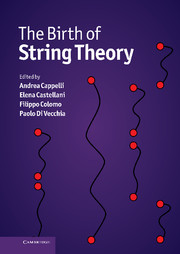Book contents
- Frontmatter
- Contents
- List of contributors
- Photographs of contributors
- Preface
- Abbreviations and acronyms
- Part I Overview
- EARLY STRING THEORY
- Part II The prehistory: the analytic S-matrix
- Part III The Dual Resonance Model
- Part IV The string
- TOWARDS MODERN STRING THEORY
- Part V Beyond the bosonic string
- Part VI The superstring
- 35 Introduction to Part VI
- 36 Supersymmetry in string theory
- 37 Gravity from strings: personal reminiscences of early developments
- 38 From the Nambu–Goto to the σ-model action
- 39 Locally supersymmetric action for the superstring
- 40 Personal recollections
- 41 The scientific contributions of Joël Scherk
- Part VII Preparing the string renaissance
- Appendix A Theoretical tools of the Sixties
- Appendix B The Veneziano amplitude
- Appendix C From the string action to the Dual Resonance Model
- Appendix D World-sheet and target-space supersymmetry
- Appendix E The field theory limit
- Index
36 - Supersymmetry in string theory
from Part VI - The superstring
Published online by Cambridge University Press: 05 May 2012
- Frontmatter
- Contents
- List of contributors
- Photographs of contributors
- Preface
- Abbreviations and acronyms
- Part I Overview
- EARLY STRING THEORY
- Part II The prehistory: the analytic S-matrix
- Part III The Dual Resonance Model
- Part IV The string
- TOWARDS MODERN STRING THEORY
- Part V Beyond the bosonic string
- Part VI The superstring
- 35 Introduction to Part VI
- 36 Supersymmetry in string theory
- 37 Gravity from strings: personal reminiscences of early developments
- 38 From the Nambu–Goto to the σ-model action
- 39 Locally supersymmetric action for the superstring
- 40 Personal recollections
- 41 The scientific contributions of Joël Scherk
- Part VII Preparing the string renaissance
- Appendix A Theoretical tools of the Sixties
- Appendix B The Veneziano amplitude
- Appendix C From the string action to the Dual Resonance Model
- Appendix D World-sheet and target-space supersymmetry
- Appendix E The field theory limit
- Index
Summary
Abstract
I describe the early developments from the formulation of the theory of the relativistic string to the construction of the first consistent superstring theory, which I witnessed from a very short distance.
The relativistic string
The story begins in October 1972, when in a CERN preprint Goddard, Goldstone, Rebbi and Thorn (GGRT) formulated a complete theory of the quantized free relativistic string [GGRT73] describing the physical states of the Dual Resonance Model.
At that time this model of strong interactions, arisen from the Veneziano amplitude proposed in 1968,was already completely developed. Fubini andVeneziano [FGV69, FV69, FV70] and Bardakci and Mandelstam [BM69] had shown that the single-particle states of the Dual Resonance Model (DRM) could be described consistently by an infinite collection of harmonic oscillators. Nambu, Nielsen and Susskind had formulated independently the conjecture that the underlying microscopic structure of these physical states was a vibrating string. Nambu was apparently the first one to use this term in such a context, writing: ‘This equation suggests that the internal energy of a meson is analogous to that of a quantized string of finite length’ [Nam70a]. Susskind used a funny paraphrase: ‘a continuum limit of a chain of springs’ [Sus69], and in a note added in proof, where the works on the factorization of the N-point amplitude by Fubini and Veneziano and by Bardakci and Mandelstam were explicitly mentioned, he used the term ‘rubber band’.
- Type
- Chapter
- Information
- The Birth of String Theory , pp. 447 - 458Publisher: Cambridge University PressPrint publication year: 2012
- 4
- Cited by



